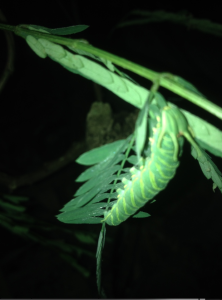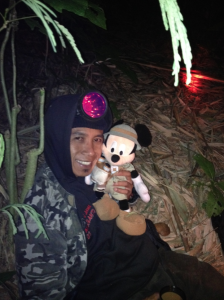Our new volunteer, Peter Rogers, has a background in creative studies. In the below blog, you can read his poetic approach to his first encounter with Shirley.
Blip… Blip… Blip… Blip…
Adin holds the satellite high above his head, the prongs silhouetted black against the sterile light of the gibbous moon. He swivels the radio transceiver, and the blips grow louder and quieter as he gages the direction our target is headed. The target in question is a loris named Shirley, also called the Shy Lady.
She is called “the Shy Lady” for good reason: ever elusive, she has been the bane of trackers and researchers alike since she was first collared in December of 2013, largely due to her preference for dense bamboo thickets. Tonight is no exception; we follow the tracking signal until our headlamps alighted upon a familiar sight.
“Ughhhhh….” Faye sighs regretfully as she gazes at the bamboo forest, with good reason. Of all the habitats lorises tend to use, bamboo is the hardest in which to track them. Thick, impenetrable, and teeming with insects and invertebrates, it is nigh impossible to maintain a constant surveillance within the terrain. As we approach the thicket, it begins to drizzle, and we are soon coated in a fine sheen of glistening moisture.

Nevertheless, we press on. As soon as we plunge into the bamboo thicket, the atmosphere changes perceptibly. The bamboo provides a shield against the light drizzle, but also pressurizes the moisture within, to the point that the humidity is almost visible; microscopic droplets hovering suspended within the air around us. The canopy surrounds us like an immense womb, and I am forced to rely entirely on the light of my headtorch as the dense mesh of leaves blocks the moon.
“Aha!” Faye points triumphantly somewhere to our left. I gaze around to see the eyes of the loris we have so desperately sought. Twin orbs of dying sunlight, bleeding out at us through the dense mesh of leaves; they vanish immediately as the two headtorches are pointed toward them.
At last, we have first contact. We settle down in the soft bed of dead bamboo leaves around us, content to give Shirley the space that the Shy Lady deserves. As we sit in the foliage, scanning the canopy for the telltale eyeshine that will give away Shirley’s presence, I reflect upon the impression that our presence must have on her.
We are children of Humanity; up-jumped primates who wear processed plants as clothing, harnessing the power of electrons to bleed light out into the cosmos. Humanity has already taken so much from Shirley and her fellow loris kin; our cities have encroached upon their jungle home, and the refuse of our overconsumption is ruining what small patches of forest are left to them.
And now we have followed this dwindling species into the last domains left to them, wielding beams of strange light to pursue them for our purpose: data collection. Nevertheless, our presence here is necessary for the continued survival of the Javan slow loris species: we must gather data in order to investigate the factors that have contributed to the species’ population decline. Furthermore, our presence scares off poachers, one of the largest threats to slow lorises in the wild.
It is the paradoxical nature of humanity that we ultimately become the very thing that we hate in the world: since a young age, I have always tried to seek the path through which I could best allow nature to reclaim the ruined tatters that humanity has made of our planet. After long years spent searching the fields of science for the most effective method by which I could pursue my plight, I found the unique niche of Primate Conservation, and eventually discovered the Little Fireface Project. Thus I was finally able to pursue my dream of rectifying the nature that Humanity has destroyed.

I am brought out of my reverie by Faye’s triumphant cry. “She’s been there all along!” I gaze toward the spotlight Faye’s headtorch makes against the foliage, and find myself gazing directly into the eyes of the very loris that we have been trying to find: twin orbs of dying sunlight; flickering embers in the fires of natural Java. The sight of her gaze burned itself into my memory that night, leaving an afterimage that time will never be able to erase.
When I looked into those eyes, I saw a reflection of myself: a tiny critter crawling upon the surface of our rock hurtling through the abyss; the urge to survive, the urge to procreate, the urge to leave some impression upon the vast universe into which we have found ourselves born.
It is so easy to give up. So easy to just sit back and just let the inevitable flow of technology roll over the world, steamrolling our charismatic megafauna and turning the natural world into a distant memory.
Yet there is hope, and I saw it within the eyes of that baleful primate within the canopy of bamboo leaves on that misty July night. Although we yet have much work to do, and many things to learn along the way, there is still hope; twin embers that we may yet reignite, shining on against the darkness of the night.
